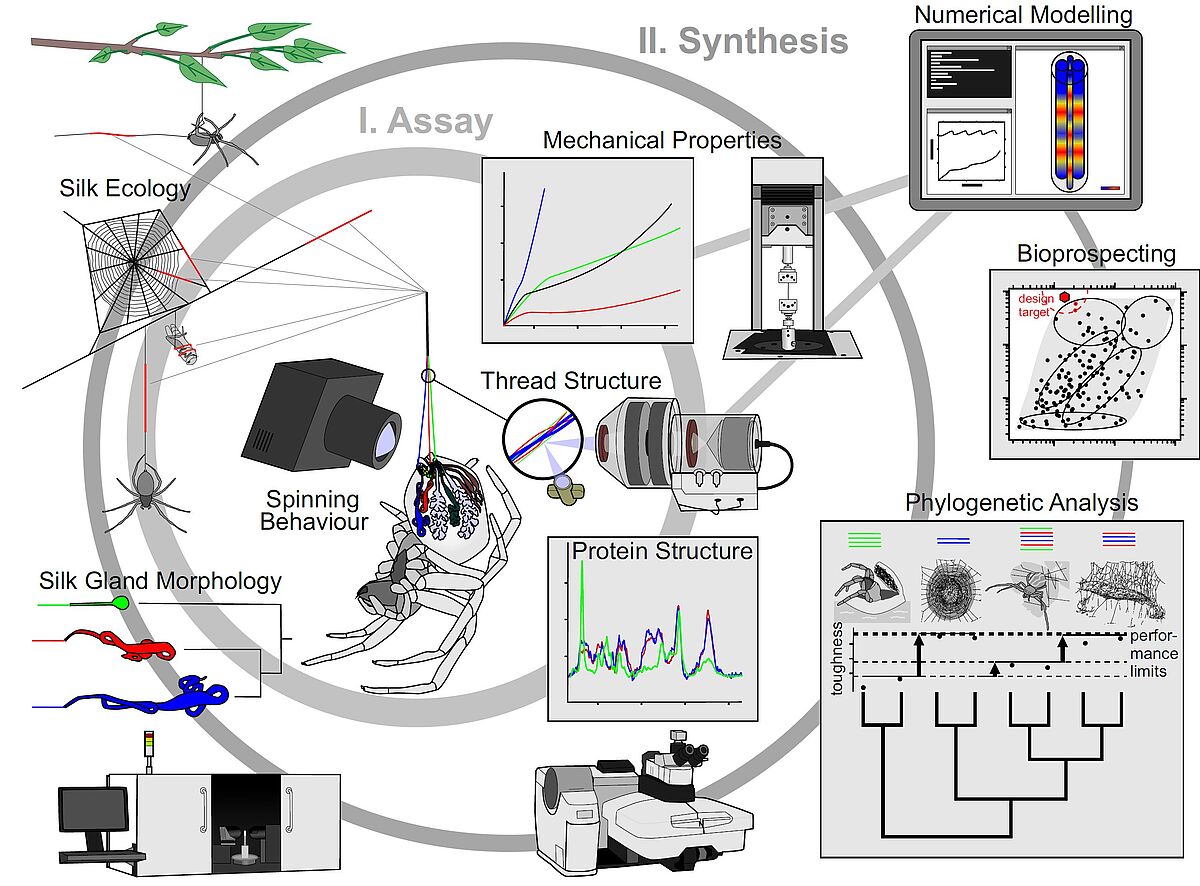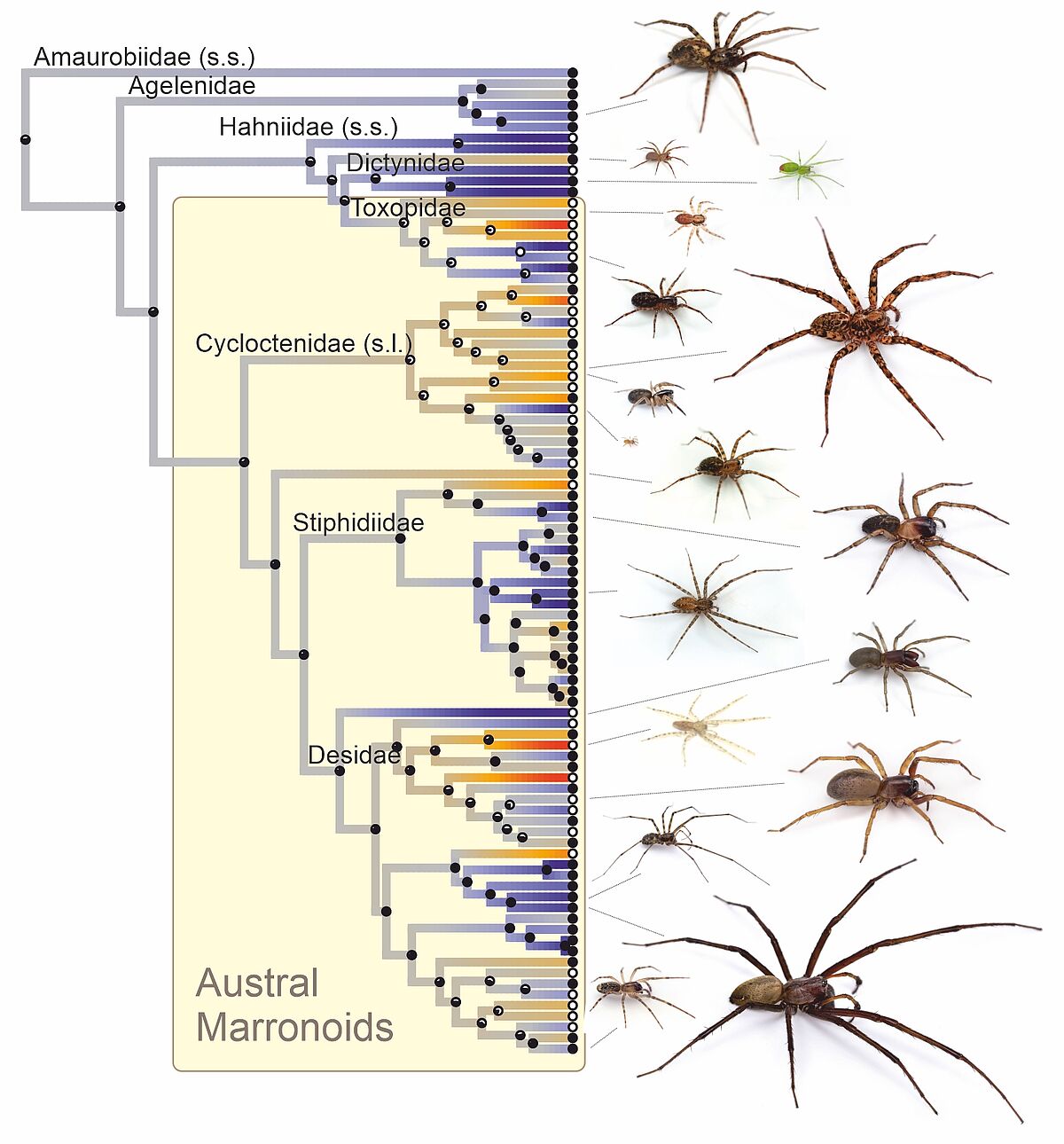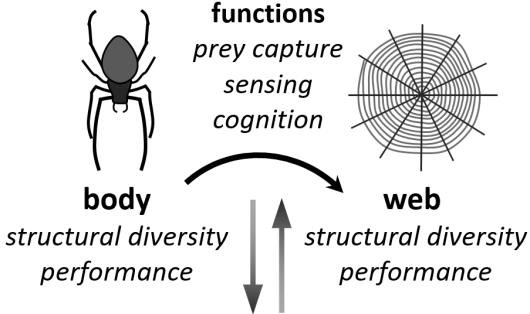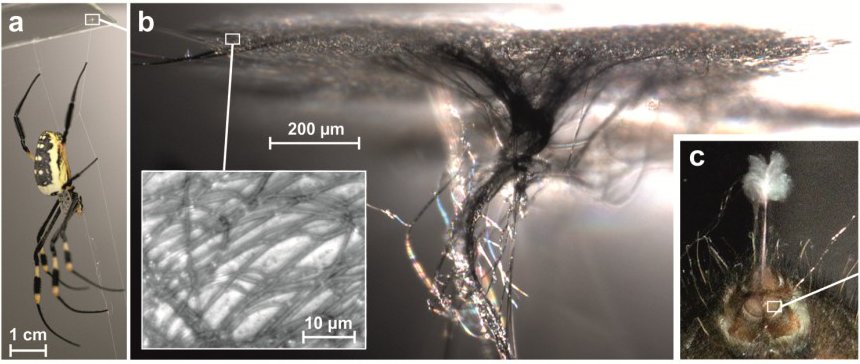Current Projects

Melding behavioural ecology and biomaterials research to track the evolution of mechanical super-performance of spider silk composites [SuPerSilk]
Many organisms assemble biological materials into architectures and tools that add and extend biological functions - with profound ecological effects, and inspiring human technologies. However, there is no general concept of how evolutionary bio-material innovation arises from both the physiological and the behavioural recombination of compounds. SuPerSilk aims to understand how mechanical super-performance evolves by disentangling the concerted effects of both physiological and behavioural factors on structure-function relationships, utilizing spiders and their silk products as a model system. Specifically, SuPerSilk will (1) determine if the diversification into different types of silk glands facilitated the evolvability of spider silk performance, (2) test if the behavioural combination of different spider silks into compound threads provides a fast track for the evolution of thread performance and an extension of performance limits, (3) test whether similar thread functions evolved via repeated or alternative pathways, and (4) establish a roadmap for the targeted bioprospecting of silk compounds with specific properties. Being the first project that will jointly track the evolution of base materials and their behaviourally assembled compound products, SuPerSilk will address a timely question in evolutionary biology: if and how the evolvability of physical traits can be modified by the evolution of novel behaviours and vice versa. The outcome will be a precedent for the integrative study of animal products that will establish a new line of research: evolutionary materials. In addition, by probing the structure-function relationship of behaviourally assembled silk composites, SuPerSilk will reinvigorate efforts to develop super-tough biofibres for industrial applications, a field that has stagnated in recent years, and enable the engineering of bio-fabrics with tailorable properties.

Funded by the European Commission / European Research Council
2022 – 2027

A window into key events of spider evolution: Tracking the phylogenetic history of a phenotypically dynamic clade of spiders - the Austral marronoids
Evolutionary key events, such as the emergence of an ecologically important trait (‘novelty’) or long distance colonization, can deliver explanations for faunal turnovers and diversification events in deep time. Key events can radically change the evolutionary dynamics (i.e. frequency and rates of changes) of traits of a lineage by extending or constraining phenotypic evolvability. However, deep time key events are poorly understood as they are often masked by ongoing evolution. This project will assess a rare exemption, a group of spiders – the Austral marronoids (Araneae: Desidae, Stiphidiidae, Cycloctenidae, Toxopidae), in which usually invariable key traits exhibit an outstanding variation, providing an opportunity to unravel how punctuated changes in the morphology of key traits change phenotypic diversification patterns. By addressing the phylogenetic history of the diverse Austral marronoids, this project will explore the evolutionary mode and dynamics of a major shift in the composition of the spinning apparatus (i.e. loss of the cribellum), the emergence of aerial webs and the loss of foraging webs, all of which are regarded as ‘key innovations’ that have shaped the extant fauna of spiders. It will uncover how these punctuated key events correlate with shifts in the evolutionary rates of phenotypic traits like body size and shape, eye arrangement and cuticular features. To achieve this, the project will build the first comprehensive genus-level phylogeny of Austral marronoid spiders using a combination of target capture and amplicon sequencing techniques. A database of morphometric and behavioural traits will be built based on microscopy and field observations. Based on the phylogenetic and morphological investigation the so far highly unstable systematics of marronoid spiders will be revised, re-defining the Austral families and re-assessing cladistics concepts of previous authors. By integrating the phylogenetic, morphological and behavioural information in a cutting-edge phylogenetic comparative framework, it will be assessed if the repeated cribellum reduction followed similar evolutionary trajectories in different lineages and how these changes interacted with the evolutionary dynamics of somatic and behavioural traits. Similar analyses will be performed on the key traits ‘aerial web’ and ‘web loss’, which are widely assumed to be homoplasic, too. This approach has a strong potential to uncover general patterns of correlated evolution and will advance the understanding of evolutionary constraints, trait evolvability and the role of extended phenotypes in organismic evolution. In addition, this project highlights the enormous scientific value of the invertebrate fauna of ancient ecosystems such as the temperate Gondwanan rainforest in Australia that is threatened by climate change driven droughts and wildfires.

Funded by the Deutsche Forschungsgemeinschaft (DFG, German Research Council)
2021 – 2025
Past Projects

Building your future: builder-building coevolution in animal architectures

Funded by the Australian Research Council
2019 – 2021

Tough stickers: How are thread anchors of spiders structurally optimized and ecologically adjusted?

Funded by Macquarie University
2016 – 2018
Side projects

EvoNEST - a data management app for the standardized and FAIR-compliant recording, storage, analysis and publication of sample and trait data for biodiversity labs.

World Spider Trait Database (WST)
We are a member of the WST core team that has esthablished and further develops a central open repository for functional traits in arachnids. LINK
Present and Past Collaborators
| Dr. Sean Blamires | University of New South Wales, Australia | Lab Homepage |
| Prof. Federico Bosia | Politecnico di Torino, Italy | Website / GoogleScholar |
| Dr. Shahan Derkarabetian | San Diego Natural History Museum, USA | Homepage / GoogleScholar |
| Prof. Mariella Herberstein | Macquarie University, Australia | Lab Homepage / GoogleScholar |
| Dr. Melissa Houghton | Department of Natural Resources and Environment (Tasmania) | GoogleScholar |
| Prof. Henrik Krehenwinkel | University of Trier, Germany | Website / GoogleScholar |
| Dr. Lauren Esposito | California Academy of Sciences, USA | Website / GoogleScholar |
| Prof. Ceridwen Fraser | University of Otago, New Zealand | Lab Homepage / GoogleScholar |
| Prof. Jessica Garb | University of Massachussets Lowell, USA | Lab Homepage / GoogleScholar |
| Prof. Gonzalo Giribet | Harvard University, USA | Lab Website / GoogleScholar |
| Prof. Sara Goodacre | University of Nottingham, UK | Website |
| Prof. Stanislav Gorb | University of Kiel, Germany | Lab Homepage / GoogleScholar |
| Dr. Anna-Christin Joel | Rheinisch-Westfälische Technische Hochschule Aachen, Germany | Lab Homepage / GoogleScholar |
| Dr. David Labonte | Imperial College London, UK | Lab Homepage / GoogleScholar |
| Dr. Arie van der Meijden | University of Porto, Portugal | Website / GoogleScholar |
| Prof. Peter Michalik | University of Greifswald, Germany | Lab Homepage / GoogleScholar |
| Prof. Ajay Narendra | Macquarie University, Australia | Lab Homepage / GoogleScholar |
| Dr. Gustavo Paterno | University of Göttingen, Germany | Website / GoogleScholar |
| Prof. Stano Pekár | Masaryk University, Czech Republic | Lab Homepage / GoogleScholar |
| Prof. Nicola Pugno | University of Trento, Italy / Queen Mary University of London, UK | Lab Homepage / GoogleScholar |
| Dr. Martín Ramírez | Museo Argentino de Ciencias Naturales - CONICET, Argentina | Lab Homepage / GoogleScholar |
| Dr. Chris Reid | Macquarie University, Australia | Lab Homepage / GoogleScholar |
| Prof. David Renault | University of Rennes, France | Lab Homepage / GoogleScholar |
| Dr. Milan Řezáč | Crop Research Institute Prague, Czech Republic | ResearchGate |
| Dr. Daniela Rößler | University of Konstanz, Germany | Homepage / GoogleScholar |
| Dr. Annika vom Scheidt | Medizinische Universität Graz, Austria | Website / GoogleScholar |
| Prof. Jutta Schneider | University of Hamburg, Germany | Website / GoogleScholar |
| Dr. Axel Schönhofer | Naturhistorisches Museum Mainz, Germany | Homepage / GoogleScholar |
| Dr. Michael Seiter | Naturhistorisches Museum Wien, Austria | ResearchGate |
| Dr. Phil Sirvid | Museum of New Zealand Te Papa Tongarewa, New Zealand | GoogleScholar |
| Dr. Helen Smith | Australian Museum, Australia | Website |
| Dr. Lauren Sumner-Rooney | Museum für Naturkunde Berlin, Germany | Lab Homepage / GoogleScholar |
| Prof. Gabriele Uhl | University of Greifswald, Germany | Lab Homepage / GoogleScholar |
